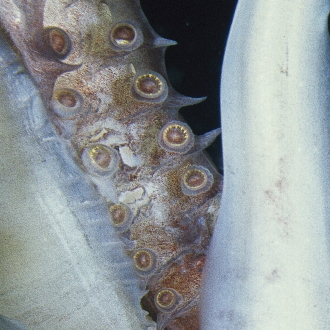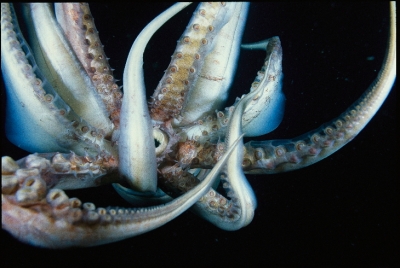The Red Demons of the Sea of Cortez
The fishermen of the Sea of Cortez in Mexico are said to call it Diablo Rojo, or Red Demon. They tell of fishermen who have fallen into the water and been dragged to horrible deaths, their bodies never recovered. The object of their fear and respect is one of the more formidable predators in the sea: the humboldt squid.

This fearsome predator (Dosidicus gigas) typically reaches 7 feet in length and weighs 100 pounds, but 14 foot, 700 pound specimens have been recorded.
The humboldt’s eight muscular arms and two tentacles are armed with up to 1,200 sucker discs, each one lined with 20 to 26 needle-sharp teeth. Few animals can escape the deadly embrace of up to 24,000 razor sharp teeth!


The attack of a humboldt takes place in less than a second. The two powerful tentacles snake out in a flash, snagging the victim and pulling it into the teeth-lined arms.
 Once it has engulfed its victim in is arms, the humboldt pulls its prey to a powerful chitinous beak located at the center of its arm Imagine the beak of a parrot, but many times larger, and with the cutting power of hydraulic scissors, which “can easily cause dramatic lacerations to human flesh,” as Wikipedia dryly notes.
Once it has engulfed its victim in is arms, the humboldt pulls its prey to a powerful chitinous beak located at the center of its arm Imagine the beak of a parrot, but many times larger, and with the cutting power of hydraulic scissors, which “can easily cause dramatic lacerations to human flesh,” as Wikipedia dryly notes.
Like most squids, the humboldt is jet-propelled, making it extremely fast and maneuverable underwater. Using water ejected through its siphon and its two powerful diamond-shaped fins, the humboldt can reach speeds up to 15 mph or faster for short bursts. The humboldt can appear out of nowhere and disappear in the blink of an eye.
Humboldts are not solitary hunters. They usually move in shoals, which may have as many as 1200 squids. There is also some evidence that they hunt in a cooperative manner, and once a large prey is trapped, they will attack en masse. This could explain why a person in the water could be quickly overwhelmed.

 My favorite account of a diver dealing with attacking humboldts is told by professional mixed-gas diver and underwater video photographer Scott Cassell, who went to the Sea of Cortez to film the red devils.
My favorite account of a diver dealing with attacking humboldts is told by professional mixed-gas diver and underwater video photographer Scott Cassell, who went to the Sea of Cortez to film the red devils.
Knowing how ferocious the humboldts could be, Cassel developed special equipment and techniques to deal with a possible attack: anti-squid armor suits; armor plating for the vulnerable parts of mixed-gas rebreather; anti-squid cage; and back-to-back diving techniques. And to prevent divers being pulled down by a pack of squid, he always made sure divers were connected to the boat by steel cables at all times.
You’d think one would be safe, with all those precautions, right? Well, here’s what happened on Cassell’s first dive with the humboldts:
“One particular moment I will never forget occurred during the first dive of the scouting expedition. Not wanting to endanger my crew, I decided to perform the first dive alone, tethered to the support boat. The crew was to stay on deck to tend my cable and pull me up in the event of trouble. As I was about to go over the side of the boat, my Mexican guide touched my arm and stared into my eyes. Although he didn’t say a word, his face said it all. He thought I was going to die. He believed the Humboldts were going to devour me, armor and all. Despite his lack of enthusiasm, I patted him on the shoulder, smiled, and continued into the water for the first time.
As soon as I hit the water I rolled onto my stomach and checked my rebreather’s function. Next, I rolled upright and reached for my camera system, but as soon as my ears were above the water I could hear the crew yelling to me: “They are right underneath you, look out!” A surge of excitement and dread filled me as I looked down past my fins. There were more than 20 giant squid right below me — not even ten feet away! Ranging in length from five to six feet, they hovered nearby just looking at me, studying me. My splash entry was like ringing a dinner bell. Suddenly, about 10 squid began to move in for a closer look. As they neared, they flashed from white to pink to bright red then back to white, all within a split second. It was beautiful! They looked like animals from another planet, totally unearthly.
As I floated there transfixed, a large squid moved to within two feet and flashed again. Mesmerized by the strobe effect, I didn’t see that another squid was rushing in from my left. Bam! It hit me with a tentacular strike that felt like being hit with a baseball bat square in the ribs. Shocked by the power of the strike and unable to breathe because of a cramp in my chest, I turned to see what had hit me and saw four more squid headed toward me. The first came in so fast that I could barely track it with the camera, and then Bam! It struck the camera, which in turn struck me in the face. I was starting to feel like I was in a barroom brawl.
After five attacks of equal ferocity, the magnificent monsters decided I was inedible and had no further use for me. With a few blasts from their massive jet funnels, they disappeared into the depths within seconds. Dazed and excited, I realized the entire ordeal lasted less than one minute. After dangling in the water for 30 minutes looking for any signs of their return, I surfaced and climbed into the boat. I later discovered bruises on me the size of oranges, as well as several scratches in my anti-squid armor suit. The system was working, but each attack left its mark — and this was just the first dive of dozens yet to come.”
 Whoa! I don’t think I’d go night swimming or snorkeling in the Sea of Cortez any time soon! As fearsome as Humboldts are, they are not supernatural monsters. They are simply superbly equipped predators that deserve our respect and admiration, even as we respect sharks or killer whales. At Santa Rosalia on the Gulf of California, Mexican fisherman catch nearly 300 tons of humboldts every day, and millions of pounds are dried and sent overseas. Because the size of humboldt populations are not known, scientists are trying to study humboldt populations in order to avoid overfishing—a problem humanity faces over the world.
Whoa! I don’t think I’d go night swimming or snorkeling in the Sea of Cortez any time soon! As fearsome as Humboldts are, they are not supernatural monsters. They are simply superbly equipped predators that deserve our respect and admiration, even as we respect sharks or killer whales. At Santa Rosalia on the Gulf of California, Mexican fisherman catch nearly 300 tons of humboldts every day, and millions of pounds are dried and sent overseas. Because the size of humboldt populations are not known, scientists are trying to study humboldt populations in order to avoid overfishing—a problem humanity faces over the world.
What we do know is that no fish population is unlimited, and it’d be a shame if this magnificent predator went the way of so many other species in our oceans.
If you’d like to read more about Cassell’s adventures with humboldts, go to his link here:
http://diver.net/seahunt/fend/f_scottc.htm
The National Geographic Channel has a very nice video of a humboldt squid here:
http://channel.nationalgeographic.com/series/wild/3365/Videos/05147_00
To learn more about these remarkable creatures and their relatives:
The Cephalopod Page
“Most cephalopods, the group in which scientists classify octopuses, squid, cuttlefish and nautiluses, can change color faster than a chameleon. They can also change texture and body shape, and, and if those camouflage techniques don’t work, they can still ‘disappear’ in a cloud of ink, which they use as a smoke-screen or decoy. Cephalopods are also fascinating because they have three hearts that pump blue blood, they’re jet powered, and they’re found in all oceans of the world, from the tropics to the poles, the intertidal to the abyss.”
http://www.thecephalopodpage.org/
Squid @ National Geographic Magazine
Some are exquisite, others monstrous, but all are quick-change artists that can alter their appearance in a flash.
http://ngm.nationalgeographic.com/ngm/0408/feature2/index.html#top
Cephalopods at the National Museum of Natural History
♥♥♥


You’ve got me shakin’ in my dive booties, man. Remind me NOT to book a dive there.
Hey mate! Couldn’t agree more….Cassell’s account is hair-raising…if he didn’t have that armor, he’d have been squid food for sure.
Thanks for dropping by from the always awesome nature photo-journal Madang – Ples Bilong Me — http://www.messersmith.name/wordpress/
Steve
Nice post. The Gulf of California, also called the Sea of Cortez .You can see town of Tijuana, YOu can see bull fighting and Jai Alai, a Spanish ball court game. The Sierra de la Laguna Biosphere Reserve. marine life of the Gulf is attract tourist. For more details refer http://www.theearthtraveler.com/whale-watching-at-the-sea-of-cortez.html
And to think I stumbled upon this story while looking for pretty fishy pictures to show my 10 year old son to get him pumped for our snorkeling in the Sea of Cortez this summer… Needless to say, he won’t be shown this article… It will be haunting me enough for both of us! Beautiful pictures of a beautiful creature, but I don’t see a “swim with the dolphins” type experience coming any time soon! 🙂
Yikes! Sorry about that! No, no “swim with the dolphins” story here, but an amazing nature story. Seriously, you should be just fine for snorkeling there, as thousands and thousands of vacationers have, and I wouldn’t hesitate to do so myself there. It’s beautiful! However, I would not go out into the deep water at night!
Thanks for stopping by and for your sense of humor. Nature is amazing, but not always “nice.”
Hope you have a wonderful trip!
Steve
what’s the best month to go to see the diablo rojo?
This is great action